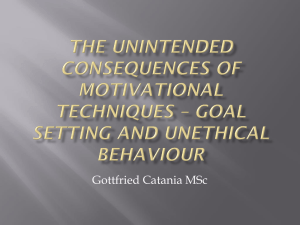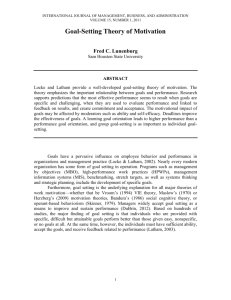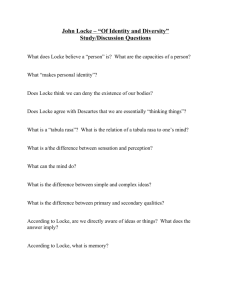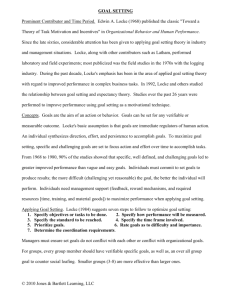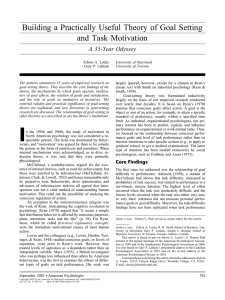New Directions in Goal-Setting Theory
advertisement
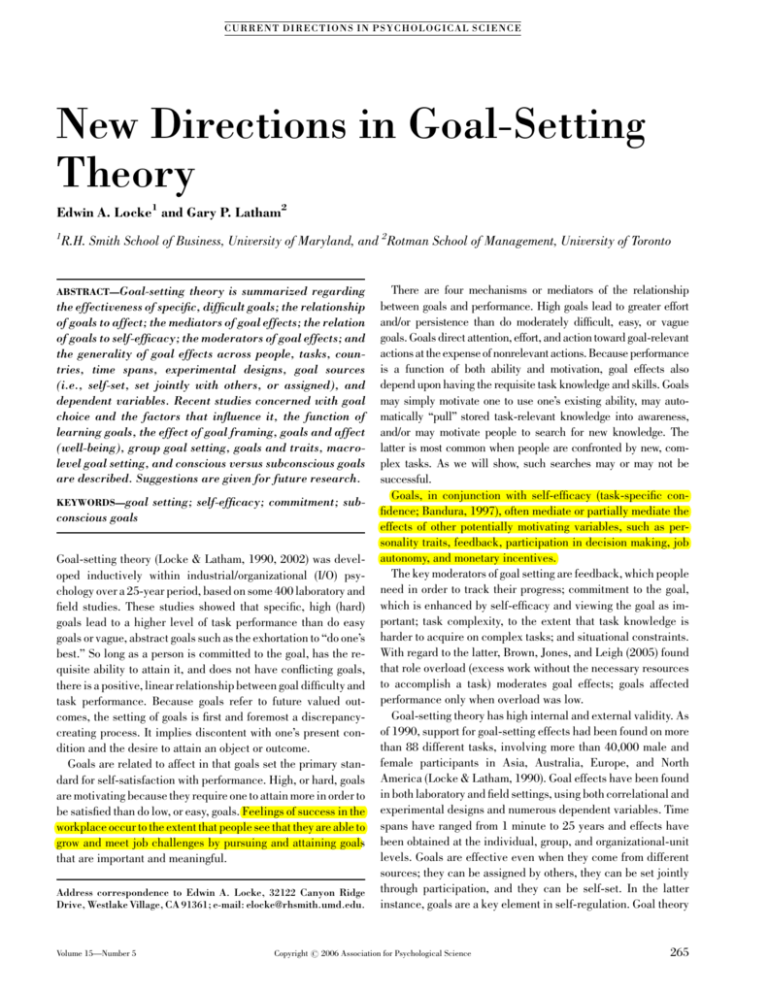
CU R RE N T D I R E CT I O NS IN P SYC H OL OGI C AL SC I EN C E New Directions in Goal-Setting Theory Edwin A. Locke1 and Gary P. Latham2 1 R.H. Smith School of Business, University of Maryland, and 2Rotman School of Management, University of Toronto ABSTRACT—Goal-setting theory is summarized regarding the effectiveness of specific, difficult goals; the relationship of goals to affect; the mediators of goal effects; the relation of goals to self-efficacy; the moderators of goal effects; and the generality of goal effects across people, tasks, countries, time spans, experimental designs, goal sources (i.e., self-set, set jointly with others, or assigned), and dependent variables. Recent studies concerned with goal choice and the factors that influence it, the function of learning goals, the effect of goal framing, goals and affect (well-being), group goal setting, goals and traits, macrolevel goal setting, and conscious versus subconscious goals are described. Suggestions are given for future research. KEYWORDS—goal setting; self-efficacy; commitment; subconscious goals Goal-setting theory (Locke & Latham, 1990, 2002) was developed inductively within industrial/organizational (I/O) psychology over a 25-year period, based on some 400 laboratory and field studies. These studies showed that specific, high (hard) goals lead to a higher level of task performance than do easy goals or vague, abstract goals such as the exhortation to ‘‘do one’s best.’’ So long as a person is committed to the goal, has the requisite ability to attain it, and does not have conflicting goals, there is a positive, linear relationship between goal difficulty and task performance. Because goals refer to future valued outcomes, the setting of goals is first and foremost a discrepancycreating process. It implies discontent with one’s present condition and the desire to attain an object or outcome. Goals are related to affect in that goals set the primary standard for self-satisfaction with performance. High, or hard, goals are motivating because they require one to attain more in order to be satisfied than do low, or easy, goals. Feelings of success in the workplace occur to the extent that people see that they are able to grow and meet job challenges by pursuing and attaining goals that are important and meaningful. Address correspondence to Edwin A. Locke, 32122 Canyon Ridge Drive, Westlake Village, CA 91361; e-mail: elocke@rhsmith.umd.edu. Volume 15—Number 5 There are four mechanisms or mediators of the relationship between goals and performance. High goals lead to greater effort and/or persistence than do moderately difficult, easy, or vague goals. Goals direct attention, effort, and action toward goal-relevant actions at the expense of nonrelevant actions. Because performance is a function of both ability and motivation, goal effects also depend upon having the requisite task knowledge and skills. Goals may simply motivate one to use one’s existing ability, may automatically ‘‘pull’’ stored task-relevant knowledge into awareness, and/or may motivate people to search for new knowledge. The latter is most common when people are confronted by new, complex tasks. As we will show, such searches may or may not be successful. Goals, in conjunction with self-efficacy (task-specific confidence; Bandura, 1997), often mediate or partially mediate the effects of other potentially motivating variables, such as personality traits, feedback, participation in decision making, job autonomy, and monetary incentives. The key moderators of goal setting are feedback, which people need in order to track their progress; commitment to the goal, which is enhanced by self-efficacy and viewing the goal as important; task complexity, to the extent that task knowledge is harder to acquire on complex tasks; and situational constraints. With regard to the latter, Brown, Jones, and Leigh (2005) found that role overload (excess work without the necessary resources to accomplish a task) moderates goal effects; goals affected performance only when overload was low. Goal-setting theory has high internal and external validity. As of 1990, support for goal-setting effects had been found on more than 88 different tasks, involving more than 40,000 male and female participants in Asia, Australia, Europe, and North America (Locke & Latham, 1990). Goal effects have been found in both laboratory and field settings, using both correlational and experimental designs and numerous dependent variables. Time spans have ranged from 1 minute to 25 years and effects have been obtained at the individual, group, and organizational-unit levels. Goals are effective even when they come from different sources; they can be assigned by others, they can be set jointly through participation, and they can be self-set. In the latter instance, goals are a key element in self-regulation. Goal theory Copyright r 2006 Association for Psychological Science 265 Goal-Setting Theory is an ‘‘open’’ theory in that new elements are added as new discoveries are made. ADVANCES IN GOAL THEORY We note eight categories of studies that have moved goal theory forward. (There is no logical order in the sections that follow.) Goal Choice Previous research on goal choice showed that self-efficacy, past performance, and various social influences affect the level at which goals are set. Enlarging on this work and moving it into the realm of sports, Donovan and Williams (2003) found that trackand-field athletes had two sets of goals, one for the season and one for the next competition. The athletes created discrepancies between past performance and future goals by setting their current season goals higher than their best previous performance. When large negative goal–performance discrepancies occurred in the current season, goals for the season were lowered. However, goals for the next competition were typically raised in order to compensate for lower-than-desired seasonal progress. There was more goal revision if athletes attributed past performance to unstable causes, such as effort, than if they attributed it to stable causes, such as ability. Learning Goals Sometimes specific, difficult goals do not lead to better performance than simply urging people to do their best (Seijts & Latham, 2001). Focusing on reaching a specific performance outcome on a new, complex task can lead to ‘‘tunnel vision’’— a focus on reaching the goal rather than on acquiring the skills required to reach it. In such cases, the best results are attained if a learning goal is assigned—that is, a goal to acquire the requisite task knowledge. Latham and Brown (in press), for example, found that entering MBA students who set specific difficult learning goals (e.g., learn to network, master specific course subject matter) subsequently had higher GPAs and higher satisfaction with their MBA program than did people who simply set a distal (long-term or end) performance goal for GPA at the end of the academic year. We believe that a learning goal facilitates or enhances metacognition—namely, planning, monitoring, and evaluating progress toward goal attainment. Metacognition is particularly necessary in environments in which there is minimal structure or guidance. Framing Assigning hard goals may not be effective when people view those goals as threatening. The concept of framing is well known in psychology, and one type of framing is in terms of gain versus loss. Whether a person appraises a high goal as a challenge versus a threat makes a difference for that person’s performance. Drach-Zahavy and Erez (2002) found that, when a task was altered to pose new challenges (but with goal difficulty held 266 constant), people who were made to view a situation as a threat (focus on failure) achieved significantly lower performance than did those who were made to view the situation as a challenge (focus on success and the usefulness of effort). Affect A 3-year study of people in managerial and professional jobs in Germany revealed that only those adults who perceived their goals as difficult to attain reported a change in affect. Goal progress and goal importance were strong predictors of feelings of success and well-being. Among the most interesting findings was that lack of goal attainment in one’s personal life was related to greater general well-being when the person experienced goal progress on the job. Evidently, success in one realm compensated for failure in the other (Wiese & Freund, 2005). Group Goals Goal setting is effective with groups too. However, groups add a layer of complexity because goal conflicts may occur among the group’s members. Seijts and Latham (2000) examined the effects of conflict versus no conflict between an individual’s and a group’s goals. In a laboratory task involving monetary incentives, they found no main effect for goal setting. However, having high personal goals that were compatible with the group’s goal enhanced group performance, whereas having personal goals that were incompatible with the group’s goal had a detrimental effect on how well the group performed. Another added feature of setting goals in groups is that taskrelevant information may be shared among group members. In an unpublished study, Locke and his colleagues found that dyads that share information perform better on a complex management simulation than do dyads who share less. The sharing effect is enhanced if the people in the dyads have high goals. DeShon, Kozlowski, Schmidt, Milner, and Wiechmann (2004) were the first to compare goal effects on individuals versus on groups. On a radar-tracking simulation, the effect of individual goals on performance was fully mediated by task strategy and individual effort. Group-level goal effects were mediated only by team-related effort. Feedback to individuals led to a focus on the individual’s performance, whereas feedback to the team led to a focus on the team’s performance. Goals and Traits The effects of goal setting as a state on the effects of goal orientation as a trait were studied by Seijts, Latham, Tasa, and Latham (2004). People with a learning goal orientation tend to choose tasks in which they can acquire knowledge and skill. Those with a performance goal orientation tend to avoid tasks where others may judge them unfavorably due to possible errors they might make. Hence they tend to choose easy tasks in which they can look good in the eyes of others. Seijts et al. (2004) found that a specific high learning goal (state orientation) is effective in increasing a person’s performance regardless of their trait Volume 15—Number 5 Edwin A. Locke and Gary P. Latham orientation. Performance is highest on a complex task, however, when people have a learning goal orientation and also set a learning goal. In short, the beneficial effect of a learning goal orientation can be attained by inducing it as a state. LePine (2005) conducted another intriguing goal-setting and goal-orientation study, using a decision-making simulation to study the ability of teams to adapt to changing circumstances. When conditions changed so that team members had to change the way they communicated, the teams that adapted best were those that had high goals as well as a high score on a learningorientation trait scale. Setting high goals was actually harmful if the teams scored low on the measure of learning orientation. In an even more complex trait-mediation study conducted in the laboratory, Lee, Sheldon, and Turban (2003) found that an ‘‘amotivated’’ orientation (i.e., low confidence in one’s capabilities) is associated with goal-avoidance motivation. This, in turn, is associated with lower goal levels and, thereby, lower performance. In contrast, a control orientation, meaning extrinsic motivation, is associated with both avoidance and approach goals. The latter are associated with higher goal levels and higher performance. Autonomy goals, meaning intrinsic motivation, led to mastery goals. Mastery goals, in turn, enhanced mental focus; so did approach goals, which, in turn, enhanced performance. This study illustrates how motivation can be measured at different levels of abstraction, with the more specific levels mediating the more general ones. Macro-Level Goals Goal-setting research has also been extended from the group level to the level of the organization as a whole. A study of companies and their suppliers in China found that the relationship between a high level of a shared vision among employees and low levels of dysfunctional opportunism was partially mediated by the setting of cooperative goals. A shared vision strengthened cooperative goal setting by drawing the boundary lines of the group around the two organizations involved—namely, the company and its suppliers—thereby reducing the negative feelings that frequently occur in alliances due to perceptions of in- versus out-groups. Baum and Locke (2004) used a longitudinal design to study the performance of small-venture entrepreneurs over a 6-year period. Growth goals, along with self-efficacy and organizational vision, were found to significantly predict future growth. These three motivators completely mediated the effects on growth of two personality traits, passion for the work and tenacity (see Fig. 1). The role of goals and self-efficacy as mediators of other motivators was also found in previous studies in which the individual was the level of analysis (Locke & Latham, 2002). Goals and Subconscious Priming To regulate behavior during goal-directed action, a consciously held goal does not have to be in focal awareness every second. Volume 15—Number 5 Communicated Vision Passion Goals Venture Growth Tenacity SelfEfficacy Fig. 1. The relationship of traits (passion and tenacity), vision, goals, and self-efficacy to the sales and employment growth of small ventures. Adapted from ‘‘The Relationship of Entrepreneurial Traits, Skill, and Motivation to Subsequent Venture Growth,’’ by J.R. Baum & E.A. Locke, 2004, Journal of Applied Psychology, 89, p. 592. Copyright 2004, American Psychological Association. Adapted with permission. Typically, a goal, once accepted and understood, remains in the periphery of consciousness as a reference point for guiding and giving meaning to subsequent mental and physical actions. Intriguing findings in social psychology by Bargh and Chartrand and others (e.g., see Bargh & Williams, 2006) suggest that even goals that are subconsciously primed (and participants report no awareness of the primed motive) affect performance. Consequently, Stajkovic, Locke, and Blair (in press) compared the effects of primed, subconscious, achievement goals with explicitly assigned, conscious, performance goals in a laboratory setting. Both priming and conscious goals had independent effects on task performance, although the conscious goal had a larger effect size. Moreover, the two types of goals had an interaction effect. Primed subjects with hard and ‘‘do your best’’ goals had significantly higher performance than did unprimed subjects with the same goals. Priming, however, did not enhance the effects of easy goals. In a follow-up study, Stajkovic and Locke used a 2 2 design in a proofreading task in which subconsciously primed speed goals and subconsciously assigned accuracy goals were crossed with explicitly assigned speed and accuracy goals. This enabled us to see what happened when subconscious goals were put in conflict with conscious goals. Using speed as the dependent variable, the two types of goals showed significant main effects, but they partly neutralized one another when they were in conflict. However, the effect of conscious speed goals was markedly greater than that of subconsciously primed speed goals. Subconscious priming had no effect at all on accuracy, but conscious goals had a strong effect. DIRECTIONS FOR FUTURE RESEARCH Goal setting can be used effectively on any domain in which an individual or group has some control over the outcomes. It has been applied not only to work tasks but to sports and rehabilitation 267 Goal-Setting Theory and can be applied in numerous other settings. The success of goal setting depends upon taking account of the mediators and moderators that determine its efficacy and applicability. Because goal setting is an open theory, there is no limit to the number of discoveries that can be made or to the integrations that might be made between goal theory and other theories. Future research could include studies of the effects of different types of learning goals and ways of combining them with performance goals (e.g., learning goals first, then performance goals), different types of goal framing (approach success vs. avoid failure), the relation between goals and cognition (which, by implication, entails all of cognitive psychology), goal hierarchies, and macro goal studies with organizations of different sizes. More studies of the relationship between conscious and subconscious goals would also be of interest. Recommended Reading Latham, G.P. (2006). Work motivation: History, theory, research and practice. Thousand Oaks, CA: Sage. Locke, E.A., & Latham, G.P. (2005). Goal setting theory: Theory building by induction. In K.G. Smith & M.A. Mitt (Eds.), Great minds in management: The process of theory development. New York: Oxford. REFERENCES Bandura, A. (1997). Self-efficacy: The exercise of control. Stanford: W.H. Freeman. Bargh, J., & Williams, E. (2006). The automaticity of social life. Current Directions in Psychological Science, 15, 1–4. Baum, J.R., & Locke, E.A. (2004). The relationship of entrepreneurial traits, skill, and motivation to subsequent venture growth. Journal of Applied Psychology, 89, 587–598. Brown, S.P., Jones, E., & Leigh, T.W. (2005). The attenuating effect of role overload on relationships linking self-efficacy and goal level to work performance. Journal of Applied Psychology, 90, 972–979. DeShon, R.P., Kozlowski, W.J., Schmidt, A.M., Milner, K.R., & Wiechmann, D. (2004). Multiple-goal, multilevel model of feed- 268 back effects on the regulation of individual and team performance. Journal of Applied Psychology, 89, 1035–1056. Donovan, J.J., & Williams, K.J. (2003). Missing the mark: Effects of time and causal attributions on goal revision in response to goalperformance discrepancies. Journal of Applied Psychology, 88, 379–390. Drach-Zahavy, A., & Erez, M. (2002). Challenge versus threat effects on the goal-performance relationship. Organizational Behavior and Human Performance, 88, 667–682. Latham, G.P., & Brown, T.C. (in press). The effect of learning, distal, and proximal goals on MBA self-efficacy and satisfaction. Applied Psychology: An International Review. Lee, F.K., Sheldon, K.M., & Turban, D. (2003). Personality and the goalstriving process: The influence of achievement goal patterns, goal level, and mental focus on performance and enjoyment. Journal of Applied Psychology, 88, 256–265. LePine, J.A. (2005). Adaptation of teams in response to unforeseen change: Effects of goal difficulty and team composition in terms of cognitive ability and goal orientation. Journal of Applied Psychology, 90, 1153–1167. Locke, E.A., & Latham, G.P. (1990). A theory of goal setting and task performance. Englewood Cliffs, NJ: Prentice-Hall. Locke, E.A., & Latham, G.P. (2002). Building a practically useful theory of goal setting and task motivation: A 35-year odyssey. American Psychologist, 57, 705–717. Seijts, G.H., & Latham, G.P. (2000). The effects of goal setting and group size on performance in a social dilemma. Canadian Journal of Behavioural Science, 32, 104–116. Seijts, G.H., & Latham, G.P. (2001). The effect of learning, outcome, and proximal goals on a moderately complex task. Journal of Organizational Behavior, 22, 291–307. Seijts, G.H., Latham, G.P., Tasa, K., & Latham, B.W. (2004). Goal setting and goal orientation: An integration of two different yet related literatures. Academy of Management Journal, 47, 227–239. Stajkovic, A.D., Locke, E.A., & Blair, E.S. (in press). A first examination of the relationships between primed subconscious goals, assigned conscious goals, and task performance. Journal of Applied Psychology. Wiese, B.S., & Freund, A.M. (2005). Goal progress makes one happy, or does it? Longitudinal findings from the work domain. Journal of Occupational and Organizational Psychology, 78, 1–19. Volume 15—Number 5
